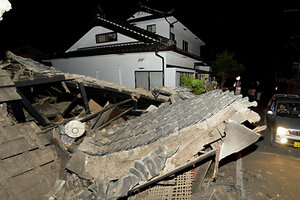Earthquake hits Japan: Was there an early warning?
Despite Japan's extensive early warning systems, damage from Thursday night's 6.2 magnitude earthquake appears to be extensive near its point of origin in southern Japan.

A roof collapses following the earthquake in Mashiki, near Kumamoto city, southern Japan, early Friday.
Tomoaki Ito/Kyodo News/AP
A strong earthquake surprised southern Japan Thursday night, causing widespread damage and possible injuries.
The Associated Press reported that the quake struck Japan’s third-largest island, Kyushu, at approximately 9:26 p.m. local time, with a magnitude between 6.2 (according to the US Geological Survey) and 6.4 (according to the Japan Meteorological Agency). Measurements between six and seven on the Richter magnitude scale indicate a “strong” quake.
Despite having the world’s most extensive early warning systems for earthquakes, Japan’s hundreds of seismic sensors can only illustrate evidence of quakes within minutes to seconds of a shock. Peggy Hellweg, operations manager at the Berkeley Seismological Laboratory (BSL), tells The Christian Science Monitor that for even the earliest warnings, “on a best case, it's two or three seconds” after the seismic event begins.
Early warning networks like those in place in Japan or California, where the BSL monitors seismic activity, pick up earthquakes’ primary and secondary, or P- and S-waves. P-waves travel faster and are the first to be detected, Dr. Hellweg explains, while causing less damage ahead of the slower S-waves and the slowest and most destructive waves, longitudinal or L-waves.
The detection of P-waves helps scientists determine the origin and magnitude of an earthquake before the S- or L-waves hit. Then, that information can be sent ahead to areas farther away from the quake’s center that are affected later by the waves.
In addition to established systems, new technology may be able to help with earthquake detection through crowdsourcing by turning people's’ handhelds into a “smartphone-based seismic network.” But such projects are still in development and not yet in place in Japan, although their usefulness could be proven in the event of a future shock there.
Even with early warnings, earthquakes are still damaging. Thursday’s seismic event was strong enough to collapse at least 19 homes, announced Japan's Chief Cabinet Secretary Yoshihide Suga, and reportedly caused damage to several other buildings.
Reuters reported that 16,000 homes were without power and 38,000 were without gas in the area around Kumamoto, the city nearest the quake’s epicenter. Local police said two people died as a result of the shock, reported Japan's NHK.
The scope of the destruction and exact number of casualties are still uncertain. Aftershocks continued through the night, including a 6.4 magnitude temblor after midnight local time.
“Because of the night darkness, the extent of damage is still unclear,” Mr. Suga said, reported the AP.
The USGS said that “Extensive damage is probable and the disaster is likely widespread,” after listing the event at a red alert level economically and a yellow alert for fatalities. The agency predicted damage could cost from $1 to $10 billion and could cause 10 to 100 fatalities.
No tsunami warning was issued in conjunction with the seismic activity. In 2011, Japan was struck by a magnitude 9 quake that triggered a deadly 30-foot tsunami that also initiated meltdowns at the Fukushima nuclear power plant.
Suga stated that there were no known issues with Japanese nuclear facilities after Thursday’s quake. After the closure of Fukushima, the only operating facility in the country is the Sendai nuclear plant, located more than 70 miles from the quake’s epicenter.
NHK reported that scientists warned that intense aftershocks could continue through the coming week.

